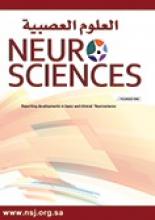Abstract
OBJECTIVE: To examine the effects of dehydroepiandrosterone (DHEA) on animal models of schizophrenia.
METHODS: Seventy Swiss albino female mice (25-35 g) were divided into 4 groups: amphetamine-free (control), amphetamine, 50, and 100 mg/kg DHEA. The DHEA was administered intraperitoneally (ip) for 5 days. Amphetamine (3 mg/kg ip) induced hyper locomotion, apomorphine (1.5 mg/kg subcutaneously [sc]) induced climbing, and haloperidol (1.5 mg/kg sc) induced catalepsy tests were used as animal models of schizophrenia. The study was conducted at the Animal Experiment Laboratories, Department of Pharmacology, Medical School, Eskisehir Osmangazi University, Eskisehir, Turkey between March and May 2012. Statistical analysis was carried out using Kruskal-Wallis test for hyper locomotion, and one-way ANOVA for climbing and catalepsy tests.
RESULTS: In the amphetamine-induced locomotion test, there were significant increases in all movements compared with the amphetamine-free group. Both DHEA 50 mg/kg (p<0.05), and 100 mg/kg (p<0.01) significantly decreased all movements compared with the amphetamine-induced locomotion group. There was a significant difference between groups in the haloperidol-induced catalepsy test (p<0.05). There was no significant difference between groups in terms of total climbing time in the apomorphine-induced climbing test (p>0.05).
CONCLUSION: We observed that DHEA reduced locomotor activity and increased catalepsy at both doses, while it had no effect on climbing behavior. We suggest that DHEA displays typical neuroleptic-like effects, and may be used in the treatment of schizophrenia.
- Copyright: © Neurosciences
Neurosciences is an Open Access journal and articles published are distributed under the terms of the Creative Commons Attribution-NonCommercial License (CC BY-NC). Readers may copy, distribute, and display the work for non-commercial purposes with the proper citation of the original work.






